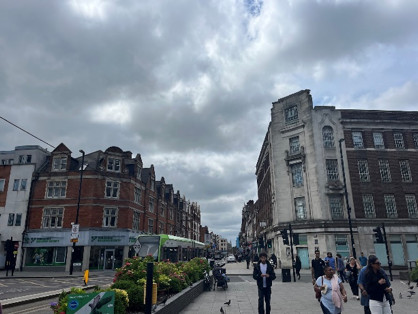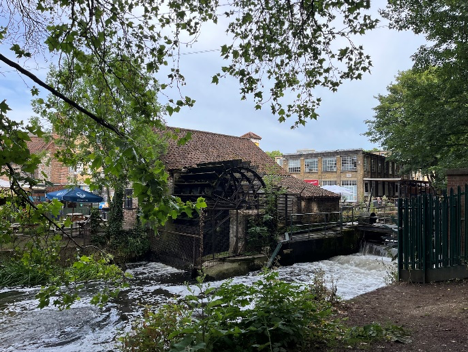Learning About Transportation in London: Burch Cleantech Europe Trip
July 17, 2023
Today, the class had the pleasure of meeting with Audrey Bowerman. A fellow UNC bachelors and master’s alum, Audrey now works for Transport in London doing work with bicycle and tram infrastructure. We met with her last week at the transportation museum and continued with the theme today as we toured the village of Croydon, its tram infrastructure, and met with the project manager of the city (Transport for London).
To begin the day, we met and had lunch at BOXPARK, a fun food hall made out of shipping containers. Afterward, we took a walk through the town, where we discussed the brutal post-WW2 architecture and the wide roadways that have been refurbished to hold more mobility types such as the tramways. Croydon was heavily bombed during the second world war, leaving the village to rebuild with the car-centric mindset of the 1950’s. However, they have adapted streets to the changing times and Croydon now utilizes bus gates for better bus efficiency and bike-friendly infrastructure. In the city center, we looked at the new single-railed tramway that passes through the main stretch of shops where the old rails used to go back in the 1800s.
Following the tour, we met with Josh Ramsey and learned about the future of Transport for London and their plans for making tramways more efficient and resilient. We discussed the process of getting new trams and refurbishing the old. He explained that it takes a long time to get new trams since they have to determine what new parts are needed and they have to figure out how to recycle the old trams. Additionally, with new trams come new staff and training, elongating rollout time. Ramsey also explained the new depot and infrastructure project, and its goal of being accomplished by 2031-32. They want to procure a new fleet of trams with options to acquire more while future-proofing for climate change with measures such as air-conditioning (which normally is not needed in the UK, but recent years have proven otherwise) and increasing efficiency of acquiring spare parts for future ridership. They also want to better manage their tram system interfaces in ways such as implementing better decision-making on prioritizing trams and the rolling stock infrastructure. Finally, they discussed the technology they have been implementing to help efficiency such as analyzing tram usage and necessity data based on ridership and using 3-D scans of tramways to ensure the trams fit on the lines when being built.
After we departed from the Transport for London office, we got back on the trams and looked at Wandle Park, an area that densified around the tramway so that commuters can better utilize the system. Then we hopped back on the tram to Therapia Lane where we toured the depot and the stabled tram-yard. Audrey explained to us that while the inter-city trams are run by humans, some longer distance light-rails are computer operated. This affects workers and efficiency but is ultimately safer in denser areas. In the depot, we took a look at the trams for check-ups and repairs. They have regular maintenance exams after a certain mileage is driven on each car. Audrey further elaborated that they are adding space for more trams in the depot yard so that they can add more trams, but are ultimately decreasing the number of running trams to allow for more back-up trams and ensure consistency in the tram schedule.

To end the day, we traveled on the tram again to Morden Hall Park. This area is part of the National Trust and includes miles of green space and a cafe area for people to enjoy. The park also includes parts of Wandle River, which was used for industrial purposes in the 1800s, but was later cleaned up and is now utilized for recreational fishing as the wildlife returned. We departed with Audrey at Merton Abbey Mills, the birthplace of the Arts and Crafts movement! However, the only crafts we saw were the craft breweries that inhabited the area to create a fun social space. Today was an awesome and interactive way to experience the tram system in London that the people we met put so much work into, and now I am sure we are all well-versed in catching and riding the trams!
About the Author
This article was written by Claire Hargrove, Class of 2025, majoring in Environmental Studies with a GIS Minor.

